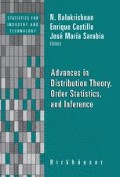Abstract
This chapter compares models for dimension reduction in time series and tests of the dimension of the dynamic structure. We consider both stationary and nonstationary time series and discuss principal components, canonical analysis, scalar component models, reduced rank models, and factor models. The unifying view of canonical correlation analysis between the present and past values of the series is emphasized. Then, we review some of the tests based on canonical correlation analysis to find the dimension of the dynamic relationship among the time series. Finally, the procedures are compared through a real data example.
Access this chapter
Tax calculation will be finalised at checkout
Purchases are for personal use only
Preview
Unable to display preview. Download preview PDF.
References
Ahn, S. K., and Reinsel, G. C. (1988). Nested reduced-rank autoregressive models for multiple time series, Journal of the American Statistical Association, 83, 849–856.
Ahn, S. K., and Reinsel, G. C. (1990). Estimation for partially nonstationary multivariate autoregressive models, Journal of the American Statistical Association, 85, 813–823.
Ahn, S. K. (1997). Inference of vector autoregressive models with cointegration and scalar components, Journal of the American Statistical Association, 92, 350–356.
Akaike, H. (1974). Markovian representation of stochastic processes and its application to the analysis of autoregressive moving average processes, Annals of the Institute of Statistical Mathematics, 26, 363–387.
Anderson, T. W. (1963). The use of factor analysis in the statistical analysis of multiple time series, Psychometrika, 28, 1–25.
Aoki, M. (1987). State Space Modeling of Time Series, Springer-Verlag, Heidelberg.
Banarjee, A., Dolado, J., Galbraith, J. W., and Hendry, D. (1993). Cointegration, Error Correction, and the Econometric Analysis of Nonstationary Data, Oxford University Press, Oxford.
Box, G., and Tiao, G. (1977). A canonical analysis of multiple time series, Biometrika, 64, 355–365.
Brillinger D. R. (1981). Time Series Data Analysis and Theory, Expanded edition, Holden-Day, San Francisco.
Casals J., Jerez, M., and Sotoca, S. (2002). An exact multivariate modelbased structural decomposition, Journal of the American Statistical Association, 97, 533–564.
Durbin, J., and Koopman, S. K. (2001). Time Series Analysis by State Space Models, Oxford University Press, Oxford.
Engle, R. F., and Granger, C. W. J. (1987). Cointegration and error correction: Representation, estimation and testing, Econometrica, 55, 251–276.
Escribano, A. and Peñ, D. (1994). Cointegration and common factors, Journal of Time Series Analysis, 15, 577–586.
Forni, M., Hallin, M., Lippi, M., and Reichlin, L. (2000). The generalized dynamic factor model: Identification and estimation, The Review of Economic and Statistics, 82, 540–554.
Geweke, J. F., and Singleton K. J. (1981). Maximum likelihood confirmatory analysis of economic time series, International Economic Review, 22, 37–54.
Hannan, E. J., and Deistler, M. (1988). The Statistical Analysis of Linear Systems, John Wiley_& Sons, New York.
Harvey, A. (1989). Forecasting Structural Time Series Models and the Kalman Filter, Second edition, Cambridge University Press, Cambridge.
Harvey, A. (2001). Testing in unobserved components models, Journal of Forecasting, 20, 1–19.
Harris, D. (1997). Principal components analysis of cointegrated time series, Econometric Theory, 13, 529–557.
Hu, Y., and Chou, R. (2004). On the Peña-Box model, Journal of Time Series Analysis, 25, 811–830.
Johansen, S. (1988). Statistical analysis of cointegration vectors, Journal of Economic Dynamics and Control, 12, 231–254.
Johansen, S. (1991). Estimation and hypothesis testing of cointegration vectors in Gaussian vector autoregressive models, Econometrica, 59, 1551–1580.
Johansen, S. (1995). Likelihood-Based Inference in Cointegrated Vector Autoregressive Models, Oxford University Press, Oxford.
Molenaar, P. C. M., De Gooijer, J. G., and Schmitz, B. (1992). Dynamic factor analysis of nonstationary multivariate time series, Psychometrika, 57, 333–349.
Peña, D. (1995). Forecasting growth with time series models. Journal of Forecasting, 14, 97–105.
Peña, D., and Box, G. (1987). Identifying a simplifying structure in time series, Journal of the American Statistical Association, 82, 836–843.
Peña, D., and Poncela, P. (2004). Forecasting with nonstationary dynamic factor models, Journal of Econometrics, 119, 291–321.
Peña, D., and Poncela, P. (2006). Nonstationary dynamic factor analysis, Journal of Statistical Planning and Inference, (to appear).
Peña, D., Tiao. G. C., and Tsay, R. S. (2001). A Course in Time Series Analysis, John Wiley_& Sons, New York.
Priestley, M. B., Rao, T. S., and Tong, J. (1974). Applications of principal component analysis and factor analysis in the identification of multivariable systems, IEEE Transactions on Automation and Control, 19, 703–704.
Quenouille, M. H. (1968). The Analysis of Multiple Time Series, Charles Griffin, London.
Rechner, A. C. (1995). Methods of Multivariate Analysis, John Wiley_& Sons, New York.
Reinsel G. C., and Ahn, S. K. (1992). Vector autoregressive models with unit roots and reduced rank structure: estimation, likelihood ratio tests and forecasting, Journal of Time Series Analysis, 13, 353–375.
Reinsel, G. C., and Velu. R. P. (1998). Multivariate Reduced-Rank Regression, Springer-Verlag, New York.
Robinson, P. M. (1973). Generalized canonical analysis for time series, Journal of Multivariate Analysis, 3, 141–160.
Shumway, R. H., and Stoffer D. S. (2000). Time Series Analysis and Its Applications, Springer-Verlag, New York.
Stock, J. H., and Watson, M. W. (1988). Testing for common trends, Journal of the American Statistical Assocation, 83, 1097–1107.
Tiao, G. C. and Tsay, R. S. (1989). Model specification in multivariate time series, Journal of the Royal Statistical Society, Series B, 51, 157–213.
Tsay, R. S., and Tiao, G. C. (1990). Asymptotic properties of multivariate nonstationary processes with applications to autoregressions, The Annals of Statistics, 18, 220–250.
Velu, R. P., Reinsel, G. C., and Wichern, D. W. (1986). Reduced rank models for multiple time series, Biometrika, 73, 105–118.
Author information
Authors and Affiliations
Editor information
Editors and Affiliations
Rights and permissions
Copyright information
© 2006 Birkhäuser Boston
About this chapter
Cite this chapter
Peña, D., Poncela, P. (2006). Dimension Reduction in Multivariate Time Series. In: Balakrishnan, N., Sarabia, J.M., Castillo, E. (eds) Advances in Distribution Theory, Order Statistics, and Inference. Statistics for Industry and Technology. Birkhäuser Boston. https://doi.org/10.1007/0-8176-4487-3_28
Download citation
DOI: https://doi.org/10.1007/0-8176-4487-3_28
Publisher Name: Birkhäuser Boston
Print ISBN: 978-0-8176-4361-4
Online ISBN: 978-0-8176-4487-1
eBook Packages: Mathematics and StatisticsMathematics and Statistics (R0)

